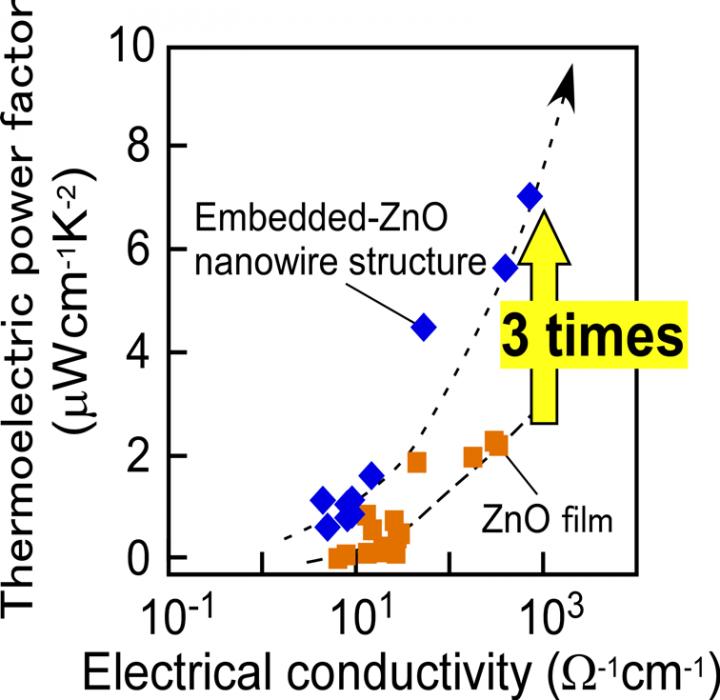
The increase of thermoelectric power factor by introducing nanowires.
Embedded-ZnO nanowire structure exhibited a thermoelectric power factor 3 times larger than that of ZnO film without nanowires….
Credit: Osaka University
Research points
- Thermoelectric generation from temperature difference in window glass is anticipated as an innovative energy source.
- Low-cost and environmentally-friendly transparent materials with high thermoelectric performance are necessary.
- Thermoelectric power factor successfully tripled simply by introducing nanowires into low-cost and environmentally-friendly ZnO films.
- Transparent thermoelectric devices, which enable energy recovery from transparent objects such as glass and transparent electronic devices, are expected to be developed using the developed methodology.
Abstract
A research group led by Professor Yoshiaki Nakamura of Osaka University successfully developed a methodology for enhancing thermoelectric power factor while decreasing thermal conductivity. By introducing ZnO nanowires into ZnO films, the thermoelectric power factor became 3 times larger than that of ZnO film without ZnO nanowires.
For the development of high-performance thermoelectric materials, expensive and toxic heavy elements have often been used; however, the high cost and toxicity have limited the social use of such thermoelectric materials. In this research, Nakamura and his team developed novel nanostructured films (Embedded-ZnO nanowire structure) composed of low-cost and environmentally-friendly ZnO. In the developed films, the thermoelectric power factor was increased by selective transmission of energetic electrons through nanowire interfaces with intentionally-controlled energy barriers, and thermal conductivity was decreased by scattering phonons at the nanowire interfaces. It is anticipated that the success of this research will lead to the realization of high-performance transparent thermoelectric devices which will enable energy recovery from transparent objects used all over the world, such as window glass and transparent electronic devices.
Research background
Thermoelectric generation converting heat to electricity has drawn much attention as a new energy source. Window glass with differing indoor and outdoor temperatures is anticipated as a heat source for thermoelectric generation, requiring transparent thermoelectric materials with high thermoelectric performance. Thermoelectric performance requires a high Seebeck coefficient, high electrical conductivity, and low thermal conductivity. However, these three parameters are intercorrelated, leading to difficulty in performance enhancement. So far, expensive and toxic heavy element materials with low thermal conductivity have often been used for the development of high-performance thermoelectric materials, limiting the use of thermoelectric generation. On the other hand, low-cost and environmentally-friendly light element-based materials exhibit low thermoelectric performance due to their high thermal conductivity in general. However, it was reported that nanostructuring achieved a significant reduction of thermal conductivity, and light element-based materials could be candidates for thermoelectric materials. But, there is still another problem in that the nanostructure scattered not only phonons but also electrons, resulting in a reduction of thermoelectric power factor.
Research content
Nakamura and his team successfully developed low-cost and environmentally-friendly ZnO films, including surface-controlled ZnO nanowire (Embedded-ZnO nanowire structure), for the first time in the world. Embedded-ZnO nanowire structure film with high optical transmittance in visible range is anticipated as a transparent thermoelectric material. In the structure, electron energy barrier height was controlled by modulating the dopant concentration at the nanowire interface, which enabled the increase of Seebeck coefficient due to selective transmission of high-energy electrons and scattering of low-energy electrons. High electrical conductivity is also anticipated because the ZnO crystal is epitaxially formed at the nanowire interface, leading to relatively high electrical conductivity of high-energy electrons. Furthermore, thermal conductivity is also decreased by an increase in phonon scattering at the nanowire interface (Figure 1).
Embedded-ZnO nanowire structures with nanowire areal density of more than 4×109 cm-2 exhibited a thermoelectric power factor 3 times larger than that of ZnO film without nanowires (Figure 2). It was confirmed that the dopant concentration was modulated at the interfaces by transmission electron microscopy observation of nanowire interfaces. The measurements of Seebeck coefficient and electrical conductivity in low temperature range (
Future work
In the future, it will be possible to greatly decrease the thermal conductivity of Embedded-ZnO nanowire structure by increasing nanowire areal density. The thermoelectric devices composed of films with this structure are expected to be realized and see widespread use due to their use of low-cost and environmentally-friendly ZnO. Furthermore, the concept of "Modulating energy barrier height by controlling dopant concentration" can be applied not only to ZnO but also to other promising materials, which will accelerate the development of various high-performance thermoelectric materials.
###
The results of this research were published in ACS Applied Materials & Interfaces on Wednesday, October 10th, 2018 at DOI: https://doi/org/10.1021/acsami.8b13528.
About Osaka University
Osaka University was founded in 1931 as one of the seven imperial universities of Japan and now has expanded to one of Japan's leading comprehensive universities.?The University has now embarked on open research revolution from a position as Japan's most innovative university and among the most innovative institutions in the world according to Reuters 2015 Top 100 Innovative Universities and the Nature Index Innovation 2017. The university's ability to innovate from the stage of fundamental research through the creation of useful technology with economic impact stems from its broad disciplinary spectrum.
Website: http://resou.osaka-u.ac.jp/en/top
Media Contact
Saori Obayashi
[email protected]
81-661-055-886
@osaka_univ_e
http://www.osaka-u.ac.jp/en
Original Source
https://resou.osaka-u.ac.jp/en/research/2018/20181031_2 http://dx.doi.org/10.1021/acsami.8b13528





